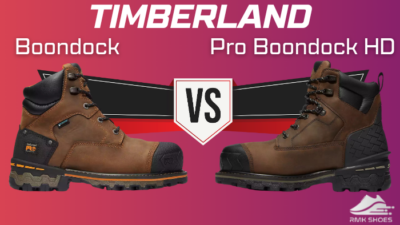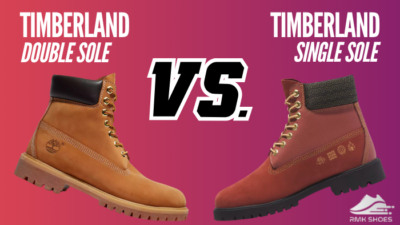In the world of running shoes, the Adidas Ultraboost and Nike Pegasus have gained immense popularity and attention for their unique features and technologies.
Both brands are bringing new versions in pursuit of perfection. Each newer one usually offers enhancements and adjustments based on athletes’ feedback and technological advancements in the running shoe design.
After testing and exploring their performance, comfort, design, and durability, I will thoroughly compare the Adidas Ultraboost 23, also known as Ultraboost Light, and Nike Pegasus 40 to help you make an informed decision.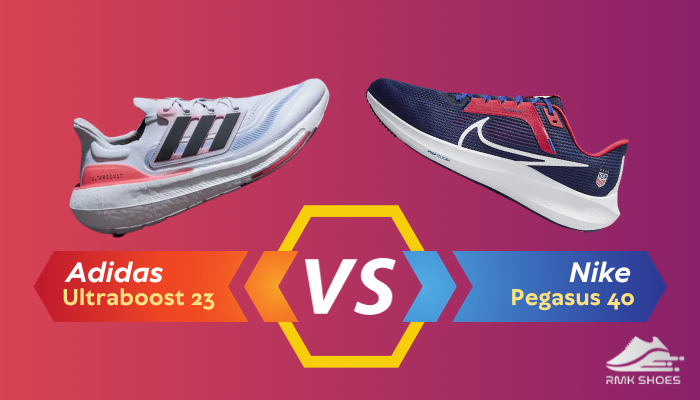
Let’s dive in.
Overview of Adidas Ultraboost Light (23) and Nike Pegasus 40
Like my little brother, you can think of Adidas as suitable for soccer or even fashion for their marketing. But they also made a name for themselves in the running industry, like Nike.
Due to the competition, both brands continued adapting to the new changes.
The Nike Pegasus is a dependable workhorse suitable for beginners and seasoned marathon runners. This brand had a significant value when I was a child, and the reputation has remained strong today with its quality and performance.
Pegasus stands out with its lightweight design, enhanced firmness, and responsiveness.
The upper provides durability and a running shoe feel, but not on the same level as the Ultraboost. These Pegasus shoes are also versatile and let you accelerate your pace effortlessly.
Adidas Ultraboost 23 was released in March 2023 and is 30% lighter, making you feel faster and more responsive on the run than before iterations.
The predecessor Ultraboost shoes had a high level of cushioning, a secure upper, and other features preventing them from becoming proper runner shoes.
But, the latest Ultraboost Light finally made this a proper runner shoe. The new Light Boost midsole foam impacts a significant factor here.
Attribute Comparison Table: Nike Pegasus 40 vs. Adidas Ultraboost Light
Both sneakers from Nike and Adidas are trendy as running shoes.
However, this comparison table will highlight the differences in design, technology, performance, etc. It will help you find the best running shoe between the two for your needs.
Here’s a quick attribute comparison table of Nike Pegasus 40 vs. Adidas Ultraboost Light (23):
| Attributes | Nike Pegasus 40 | Adidas Ultraboost Light |
|---|---|---|
| Upper Material | Lightweight mesh upper | Thick Primeknit+ |
| Midsole Material | Front and heel Zoom Air bags, React foam | Light Boost |
| Tongue | Sleeved and padded | No additional tongue piece |
| Stack Height | Heel: 33 mm / Forefoot: 23 mm | Heel: 29.3 mm / Forefoot: 19.3 mm |
| Heel-to-toe drop | 10mm | 10mm |
| Flexibility | Flexible | Medium |
| Sizing | True-to-size | True-to-size |
| Cushion Amount | Medium cushioned | Highly cushioned |
| Weight | Around 9.4 ounces | Around 10.3 ounces |
| Price | Starts from $130 | Starts from $190 |
Now, let’s dive into detailed comparisons.
Key Difference Between Adidas Ultraboost 23 vs Nike Pegasus 40
Adidas Ultraboost and Nike Pegasus have been a staple in the running community.
Both brands continued to innovate and create shoes that appeal to various runners. As they possess some differences, one chooses one brand over the other.
Here are the key differences between the Adidas Ultraboost Light and Nike Pegasus 40:
Design and Appearances
With a sleek and modern design, Ultraboost brings their A-game.
Their signature Boost midsole enhances the elegance. It looks similar to Ultraboost 22.
Conversely, Nike Peg 40 shoes have a more timeless design with the iconic Nike Swoosh and clean lines.
I must say they are never outplayed when it comes to style.
Nike also changed the footbed design to make it more supportive and secure. A small vertical reflective stripe on the back of the heel is also attractive.
With Ultraboost, a wide range of vibrant and eye-catching colorways let you unleash your inner fashionista.
But what does Nike bring to the table?
Besides their default offering, they let you customize the whole shoe on their website to match your shoes to your mood. I was amazed at this.
Regarding style, I liked both the Ultraboost Light and Pegasus 40.
Build Quality and Construction
Nike has significantly changed the upper part of the Pegasus 40 compared to its predecessor, the Pegasus 39.
The improvements feature a roomier toe box, arch, and heel area to provide comfortability.
Moreover, they changed the lacing system for improved midfoot lockdown, but the heel lockdown wasn’t impressive to me.
Similar to Pegasus 39, the newer one also has an internal heel counter.
I noticed that they had reworked the internal linings. The tongue is also fully gusseted.
In addition, the softer and more stretchy single-layer mesh upper was also comfortable for padding. The adequate cushioning around the tongue and the collar feels impressive for a smooth ride.
On the other hand, Ultraboost Light features a super stretchy upper that gives a locked-in foot feeling on the run.
The thick Primeknit+ material is pretty tough on the upper fiber, containing at least 50% Parley Ocean Plastic and 50% recycled polyester.
However, one of my friends with high arches found it challenging to wear the shoes.
In my test, even though there are elevated foam pads inside the heel for overall foot lockdown, I’m disappointed that I still can’t do a runner’s knot on these shoes for a high level of heel lockdown.
The thick knitted upper was not very breathable, but it will be enjoyable in cool climates.
I liked the Pegasus 40 more than the Ultraboost 23 regarding build quality and construction.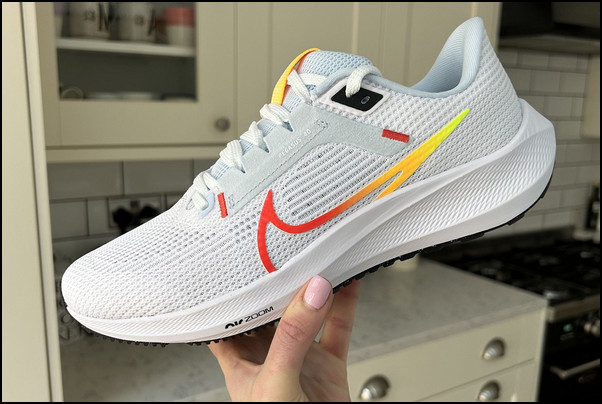
Outsole, Midsole, and Insole
Regarding the foundation of a running shoe, the soles play a crucial role in determining the overall performance and comfort.
As runners look into a shoe’s support, responsiveness, and comfort, a closer examination of the sole designs can help to consider their preferences.
Outsole
Pegasus 40 from Nike features a rubber outsole with a waffle-style pattern.
In my test, it provided good traction on wet concrete. I didn’t experience any slipping issues. The tread was effective enough to grip various surfaces, ensuring stability during runs.
The thick Duralon on the forefoot and harder BRS 1000 on the heel seem not to wear down prematurely.
Conversely, the outsole design of the Ultraboost Light reminds me of the Ultraboost 22. It is pretty similar to the Continental rubber outsole, which I found ideal for light trail running.
The extra plastic support along the arch of the outsole helped mitigate the pronation during the run.
Midsole
Nike Pegasus 40 uses Nike’s React midsole foam, which has been used since Peg 37 shoes.
In addition, the Zoom Air units, one in the forefoot and another in the heel of the shoe, help for a bouncy, responsive ride.
However, Pegasus 40 offers less cushioning than some other Nike models, such as the Invincible Run 2 and 3, which feature softer ZoomX foam.
Instead, it uses React foam, which is notably firmer. But they didn’t bother me as they provided added responsiveness.
I’m confident that the shoe will be well-suited for tempo runs or race-pace sessions.
On the other hand, Adidas used the new Light BOOST foam, which is 30% lighter than its predecessors.
It significantly reduced the overall shoe weight.
For example, whereas Ultraboost 22 had 11.7 ounces, Ultraboost Light brought it to only 10.3 ounces, which is impressive.
Ultraboost 23 still has the lower instep height and a snug heel fit as the Ultraboost 22. In addition, it also incorporates the Linear Energy Push (LEP) system.
However, the Light BOOST foam doesn’t deliver a plush feel underfoot despite the thick foam wedge.
While the firmer foam can give you slightly more versatility on the run, you will be disappointed if you expect an overly plush experience.
Insole
In Pegasus 40, the default footbed isn’t thick.
I changed to a thicker insole, which was a much better experience.
However, one of my friends told me he struggled with thick heel aftermarket insoles inside the Pegasus 40.
The Adidas Ultraboost insole uses EVA foam, and it is also removable.
Regarding sole units, Nike Pegasus is the winner to me.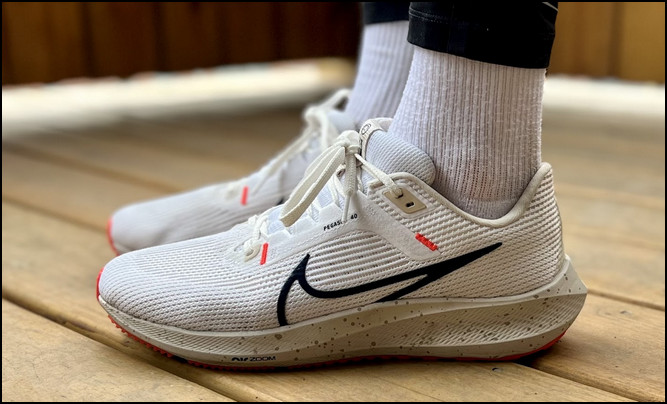
Fit and Stability
Fit and stability matter for a runner shoe. The shoes generally won’t provide stability if they don’t fit you.
Fit
Nike’s Pegasus 40 was a comfortable fit for me due to its true-to-size sizing. The shoe gradually tapers in the midfoot and heel.
The engineered mesh provides ample stretch and wiggle room.
In addition, the internal mesh gusseting adds an additional layer of support and comfort.
I liked the heel collar as it is highly padded, which enhances comfort. But if you are sensitive to heel counters, you may experience some discomfort.
Overall, it offers excellent security and a comfortable fit.
On the other hand, Ultraboost Light from Adidas also fits true to size in length but has a slightly wider width, resulting in a low-volume feel.
The upper also provides a snug and comfortable fit.
In my test, I found the likelihood of lateral and superior movement during faster runs due to the lack of the last eyelet, even though the absence of a traditional tongue results in a seamless midfoot fit.
Despite this, the effective heel counter offers support and stability. But, I wished it was better for high-intensity activities.
Stability
Nike Pegasus 40 provides a classic, neutral running experience with a stable and firm sole. My flat-footed friend liked this shoe for enhanced stability and control.
In this regard, it doesn’t offer significant arch support.
However, the low-profile design is more manageable for those with sensitive feet. Overall, the shoe delivers a snug fit and a responsive ride.
In contrast, despite not being a stable shoe, Ultraboost 23’s wide sole is one feature that contributes to its stability as a neutral shoe.
The extensive external heel counter and a stiff forefoot provide stability during runs.
While the Light Boost offers cushioning, it contributes to a more stable feel. Thanks to the increased midsole firmness and stiffness up front.
Regarding fit and stability, the Pegasus 40 is slightly ahead of the Ultraboost 23.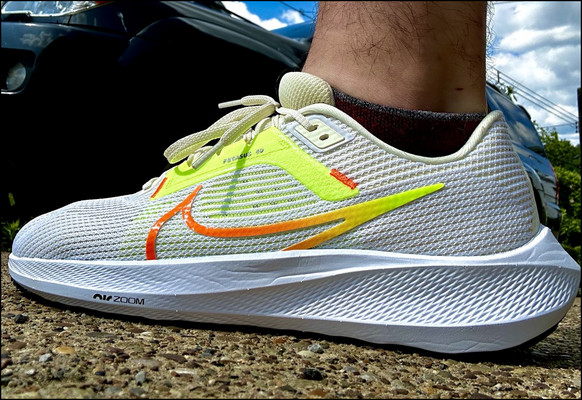
Performance and Comfort
The Nike Pegasus 40 gave me substantial support and comfort during my test. The shoes delivered a commendable amount of cushioning on easy runs.
However, I wished for a slightly more responsive feel.
Despite this, I could still hit my intended pace in the Pegasus 40.
For novices, they are excellent for their durability and versatility. Thanks to the React foam and Zoom Air units.
For experienced fast runners, they might be better suited for easy runs.
Overall, like me, you will also like the 40th iteration of the Pegasus line.
In contrast, the new midsole foam makes a noticeable difference in the Ultraboost Light compared to the previous Ultraboost 22 and 21.
Though it is still heavier than the Nike Pegasus 40, I loved the lighter feel of the shoe and the responsive experience while running.
If you are new to the Ultraboost line, the shoe doesn’t offer an overly plush underfoot feel, which you can find uncomfortable.
Throughout various running sessions, the shoe proved to be a well-rounded option.
But it is worth mentioning that one of my friends got blisters on the heel during his first two running sessions.
I loved the Nike Pegasus 40 for being lighter than the Adidas Ultraboost Light.
Price, Value, and Availability
Everyone wants to get the most bang for their buck. So, let’s learn the essential and favorite topic– price and value.
Price and availability
When considering price, the Adidas Ultraboost Light comes with a hefty price tag compared to the Pegasus 40 of Nike.
With innovative and stylish features, the Ultraboost is widely acknowledged as a top-tier running shoe, hence the premium price.
The Adidas Ultraboost Light costs around $190/£170. It runs from a US 5 to 18 in the men’s shoe, and a US 5 to 12 for women.
In contrast, the Pegasus 40 provides a more budget-friendly choice, ensuring accessibility without compromising performance and comfort.
You can get Nike Pegasus 40 priced at around $130/£125 from Nike and third-party retailers.
The men’s shoes come in US 6-18 and are available in regular and extra-wide sizes. The women’s version ranges from sizes US 5-12.
While it is slightly more expensive than Pegasus 39, it’s still cost-effective.
Value
Though there are price differences, the Ultraboost and Pegasus deliver excellent value for money.
The Ultraboost earns praise for its luxurious feel and performance-enhancing features, making it a worthy investment for serious runners.
In contrast, the Pegasus 40 from Nike delivers impressive performance at a wallet-friendly cost, establishing itself as a favored option for all runners.
Overall, price-wise, the Nike Pegasus 40 is the winner here, but regarding value, I say they are a tie.
Pros & Cons of Adidas Ultraboost 23 and Nike Pegasus 40
Adidas Ultraboost 23 and Nike Pegasus 40 are the perfect running shoes, offering unique features catering diverse needs of runners.
The runners must carefully consider the advantages and disadvantages to ensure an optimal match when deciding which shoe best suits them to achieve the best possible outcome.
Here are the pros and cons of Adidas Ultraboost 23 and Nike Pegasus 40:
Adidas Ultraboost 23
- »Visually appealing design.
- »Improved overall stability during running.
- »Enhanced heel lockdown.
- »Lightweight compared to Ultraboost 22.
- »Snug and comfortable fit.
- »Not pocket-friendly.
- »Lacks dynamic responsiveness while running.
- »Firm midsole foam can lead to less comfort.
Nike Pegasus 40
- »Robust and long-lasting outsole.
- »Affordable price point.
- »Secure and stable fit for good lockdown.
- »Reliable everyday running ride.
- »Enough cushioning to enhance comfort.
- »Falls short in energy return.
- »Increased weight from its predecessor.
Adidas Ultraboost Light vs Nike Pegasus 40: Which Should You Choose?
Regarding the decision between the Adidas Ultraboost 23 and Nike Pegasus 40, both shoes excel in outstanding performance and comfort.
The Ultraboost stands out with its luxurious feel and cutting-edge technologies, making it a favorite among runners.
In contrast, Pegasus 40 offers a reliable and more budget-friendly alternative without sacrificing quality.
In the end, the decision comes down to personal preference, running style, and budget.
Between the two, I liked the Nike Pegasus 40 for being slightly cheaper and versatile. It is a perfect fit for me and will be an ultimate running partner for some time.
If you desire a plush footwear experience and have some extra funds to spare, go for the Adidas Ultraboost.
Conversely, opt for the new Pegasus for more performance-focused and budget-friendly shoes.
FAQs
Are the Adidas Ultraboost 23 and Nike Pegasus 40 suitable for long-distance running?
The Adidas Ultraboost 23 and Nike Pegasus 40 are excellent long-distance running choices. The advanced cushioning technologies and supportive design help to reduce the risk of fatigue and injury during extended runs. However, you should also take into consideration the individual running style.
Which shoe offers better breathability? Adidas Ultraboost Light or the Nike Pegasus 40?
The Adidas Ultraboost Light and Nike Pegasus 40 have breathable upper to enhance air circulation and keep the feet cool. While Ultraboost 23 uses Primeknit upper, Pegasus 40 comes with mesh upper. Overall, the Pegasus 40 has slightly better breathability than the Ultraboost Light.
Are Nike Pegasus 40 and Adidas Ultraboost 23 suitable for various types of running terrains?
Nike Pegasus 40 and Adidas Ultraboost 23 shoes are primarily designed for road running. However, you can use those on various terrains occasionally. It is best to use dedicated trail running shoes for dedicated trails.

